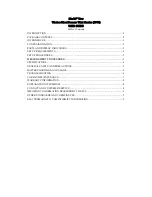
2.3. What can be done, if regular increased/low values are obtained?
a)
Please consult your doctor.
b)
Increased blood-pressure values (various forms of hypertension) are associated long- and
medium term with considerable risks to health. This concerns the arterial blood vessels of
your body, which are endangered due to constriction caused by deposits in the vessel walls
(Arteriosclerosis). A deficient supply of blood to important organs (heart, brain, muscles) can
be the result. Furthermore, with long-term continuously increased blood-pressure values, the
heart will become structurally damaged.
c)
There are many different causes of the appearance of high blood pressure. We differentiate
between the common primary (essential) hypertension, and secondary hypertension. The
latter group can be ascribed to specific organic malfunctions. Please consult your doctor for
information about the possible origins of your own increased blood pressure values.
d)
There are measures which you can take, not only for reducing a medically established high
blood pressure, but also for prevention. These measures are part of your general way of life:
A) Eating habits
•
Strive for a normal weight corresponding to your age. Reduce overweight!
•
Avoid excessive consumption of common salt.
•
Avoid fatty foods.
B) Previous illnesses
Follow consistently any medical instructions for treating previous illness such as:
•
Diabetes (Diabetes mellitus)
•
Fat metabolism disorder
•
Gout
C) Habits
•
Give up smoking completely
•
Drink only moderate amounts of alcohol
•
Restrict your caffeine consumption (Coffee)
D) Physical constitution:
•
After a preliminary medical examination,
do regular sport.
•
Choose sports which require stamina and avoid those which require strength.
•
Avoid reaching the limit of your performance.
•
With previous illnesses and/or an age of over 40 years, please consult your doctor before
beginning your sporting activities. He will advise you regarding the type and extent of types
of sport that are possible for you.
4
Summary of Contents for BP 3BE0-4
Page 27: ...24 48...
Page 29: ...26 1 1 1 1 2...
Page 30: ...27 2 2 1 2 2 90 140 100 60...
Page 31: ...28 100 60 140 100 90 60 160 140 100 90 180 160 110 100 180 110 120 2 3...
Page 32: ...29 40...
Page 33: ...30 3 19 5 13 5 19 5 13 5 WC1 4 4 1 1 5 2 O I...
Page 34: ...31 1 5 AAA 1 2 4 2 4 3 1 M Time Time M 2 3 Time 4 5 Time...
Page 35: ...32 5 5 1 5 2 15 10 5 3 10...
Page 36: ...33 5 4 O I 75 73 118 5...
Page 38: ...35 HI 300 5 200 LO 40 1 2 1 2 5...
Page 39: ...36 7 8...
Page 41: ...40...
Page 43: ...42 1 1 1 2 1 Pacemaker...
Page 44: ...43 2 1 2 2 2 mmHg 90 mmHg 140 100 mmHg 60 mmHg...
Page 45: ...44 mmHg 100 60 140 100 90 60 160 140 100 90 180 160 110 100 180 110 mmHg 120 3 2...
Page 46: ...45 40...
Page 47: ...46 3 19 5 13 5 19 5 13 5 4 1 4 1 5 LCD Time MEMORY Start O I...
Page 48: ...47 1 5 AAA 1 2 O I 2 4 3 4 1 M Time M 2 3 4 3 5...
Page 49: ...48 5 1 5 5 2 5 15 mmHg 10 3 5...
Page 50: ...49 10 4 5 O I START...
Page 52: ...51 6 2 ERR 1 ERR 2 artefact ERR 3 ERR 5 HI 300 5 200 LO 40 1 2 1 5 2...
Page 53: ...52 7 2...
Page 54: ...53 8 3 9 145 75 70 80 50 5 90 15 40 10 mmHg 280 30 200 40 mmHg 299 0 40 10 15 95 15 95 55 20...








































